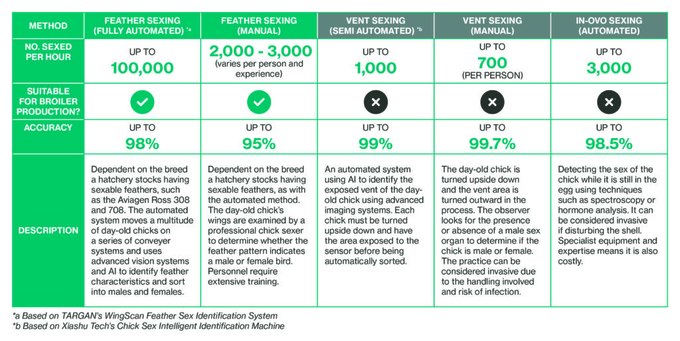June 17, 2025 | 09:45 GMT +7
June 17, 2025 | 09:45 GMT +7
Hotline: 0913.378.918
June 17, 2025 | 09:45 GMT +7
Hotline: 0913.378.918
The OECD-FAO Agricultural Outlook 2023 forecasted that poultry would comprise 40% of global meat production that year, with a predicted increase from 142 million tonnes produced in 2023 to 153 million tonnes by 2030. Although welcome growth to the sector, it brings added pressure on producers and integrators to optimise efficiencies and boost productivity — while maintaining high standards of animal welfare throughout the production chain.
Modern poultry operations benefit from today’s advanced technologies, such as artificial intelligence (AI) and robotics, which can be utilised across various stages of production. Wherever they’re introduced, there can be transformative knock-on effects felt throughout the entire poultry value chain.
Although its adoption varies globally, chick sexing is a crucial step that can significantly boost the bottom line for producers, farmers, processors and integrators.
In more developed countries with advanced poultry industries, the practice is widely implemented, with producers looking for new automated methods that can enhance efficiency throughout the production process.
Separating males and females early on brings a whole host of benefits, including the ability to implement sex specific management and feeding practices that can reduce FCR, enhance predictability of days to achieve target weight, and improve weight uniformity at the plant.
In developing countries, the value of chick sexing is widely understood, and many poultry producers have implemented this practice. However, the primary challenge remains finding qualified labour to perform manual sexing, as automated technology has only recently become accessible.
Several methods are employed for chick sexing, each with its own benefits and limitations.

As illustrated above, automated imaging systems using AI are beginning to infiltrate the market due to the multitude of benefits across the broiler production value chain, including:
Efficiency: Reduced labour translates to a reduction in costs and minimised human error. Systems such as WingScan (TARGAN) allow larger quantities of chicks to be processed at standard mega hatchery throughputs, ensuring timely delivery to farms and markets.
Production: Feeding regimes and housing conditions can be tailored to the specific needs of male and female chicks, supporting overall health and productivity.
Welfare: Fully automated systems eliminate human interaction during the sexing process, reducing stress from handling and decreasing mixed-sex competition at farms.
Demand: Markets often prefer specific poultry products to meet consumer preferences and regulatory standards. Automated systems efficiently sex chicks, addressing increasing production demands and meeting market needs effectively.
Launched in 2023, TARGAN’s automated feather sex identification system utilises sophisticated vision systems to accurately identify day-old chicks. It transfers chicks on a series of conveyor belts and uses AI algorithms to sort males and females, with up to 98% accuracy. This translates into improved uniformity in bird weight on the farm and more efficient downstream processing, resulting in improved productivity, welfare and cost savings.
The WingScan system has processed millions of bird images, including various ages, producers, and incubation times, among many other factors. This extensive exposure allows its machine learning to continuously improve its AI algorithms through usage and expert review. Each WingScan system is meticulously designed to fit into existing hatchery setups and is intended to integrate into existing automation, positioned between shell separation and vaccination.
The future of the poultry industry lies in the hands of early adopters of advanced AgTech systems. By integrating engineering and biology, and embracing AI, poultry production is set to become more ethical, productive, and profitable. These innovations promise to transform the industry far beyond the hatchery, ensuring the rising global demand is met with quality animal protein products. Producers will benefit from increased efficiency and cost savings, consumers will enjoy high-quality products, and animals will experience improved welfare. This forward-looking approach positions the industry at the forefront of a new era in poultry production.
(Poultryworld)

(VAN) Extensive licensing requirements raise concerns about intellectual property theft.

(VAN) As of Friday, a salmonella outbreak linked to a California egg producer had sickened at least 79 people. Of the infected people, 21 hospitalizations were reported, U.S. health officials said.

(VAN) With the war ongoing, many Ukrainian farmers and rural farming families face limited access to their land due to mines and lack the financial resources to purchase needed agricultural inputs.

(VAN) Vikas Rambal has quietly built a $5 billion business empire in manufacturing, property and solar, and catapulted onto the Rich List.

(VAN) Available cropland now at less than five percent, according to latest geospatial assessment from FAO and UNOSAT.

(VAN) Alt Carbon has raised $12 million in a seed round as it plans to scale its carbon dioxide removal work in the South Asian nation.

(VAN) Attempts to bring down the price of the Japanese staple have had little effect amid a cost-of-living crisis.